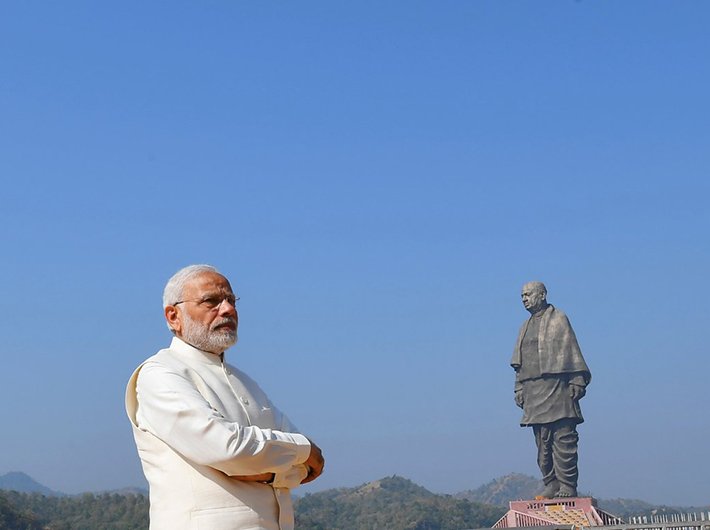Before he laid the foundation for the world’s tallest statue of India’s first deputy prime minister, Sardar Vallabhbhai Patel, on October 31, 2013, Narendra Modi (then chief minister of Gujarat), used to keep a small-scale prototype of the proposed statue on the desk in his office. When hosting foreign dignitaries in the office, he would spend considerable time in explaining the significance of the grand project. He even gifted small replicas to some of them.
Iconography is not only an art but also intrinsic to politics. Five year later, now as prime minister, when he dedicated to the nation the 182-metre tall statue, Modi has completed his appropriation of an icon who originally belonged to the Congress but has been forgotten by his own party. In this politically astute move, Modi would convince the history that Patel belonged more to him and the BJP than to the Congress.
He made sure that people of India were with him in this ambitious initiative. He persuaded people across the country to emotionally invest in building of the statue. In the first leg of building the structure, he demanded that agriculture implements and other tools be donated from every village of the country to make provision for the iron in making of the statue. The drive mobilised BJP workers and other nationalist organisations apparently to correct a “historical wrong” perpetuated by a dynastic Congress that could not look beyond one family.
There is no doubt that in terms of the size and scale, Modi today on the occasion of the 143rd birth anniversary of the great leader dedicated the Statue of Unity – at Kevadia Colony, the site of the Sardar Sarovar Dam in central Gujarat – that has dwarfed all larger-than-life statues in the world. In popular psyche, it would leave an ineradicable imprint that Sardar Patel was a counter-icon whose contribution to nation-building was disingenuously undermined by his own party, the Congress, monopolised by a bunch of power-seekers. For future historians, a tablet recording the contribution of villages and every individual in the making of the statue is preserved for records’ sake.
Perhaps politicians know it better than most that much of the history writing goes by the records. The fact that Patel has been dusted off from the record book and refurbished and revitalised as an unparalleled icon of India’s freedom struggle goes to the credit of Modi and the BJP. Forget about the history of Patel’s run in with the Rashtriya Sawayamsevak Sangh (RSS) following the assassination of Mahatma Gandhi. And certainly it would be futile at the moment to recall the fact that the RSS was proscribed for the first time during Patel’s tenure as the home minister.
In essence, the realisation of Modi’s Sardar project is calculated to effect a paradigm shift in politics. It is a determined attempt to highlight a right-wing, nationalist stream of the Congress represented by Patel and others like Purushottam Das Tandon and KM Munshi. Historically this space was constricted within the party by Jawaharlal Nehru and his left-leaning colleagues within the party. Modi has brought that stream to the foreground.
But it would be naïve to believe that Modi is merely aiming at only capturing the right-wing, nationalist political space. In his 50-minute speech today, Modi combined his political objectives quietly deftly by emphasising on the ‘India is eternal’ theme to the appropriation of other national and regional icons of society. For instance, he referred to the creation of a monument for Dr BR Ambedkar and the building of a tall statue of Sir Chhotu Ram in Haryana. In the same breath, he also referred to revolutionaries like Shyamji Krishna Varma, Bhagat Singh and Netaji Subhash Chandra Bose.
It is nobody’s argument that the co-option of historical icons by Modi and the BJP would translate profitably into votes. But there is little doubt that it enables the party to produce an affective political narrative that may find resonance across the country. At the same time, such moves also enable the party’s cadre to get charged and mobilised beyond the ideological blindfold and approach people beyond the traditional support base. This is the context in which Modi’s innovative politics is significant while the Congress seems stuck in the old groove, harping on issues that have lost touch with masses.
[This comment has appeared on FirstPost.com]

